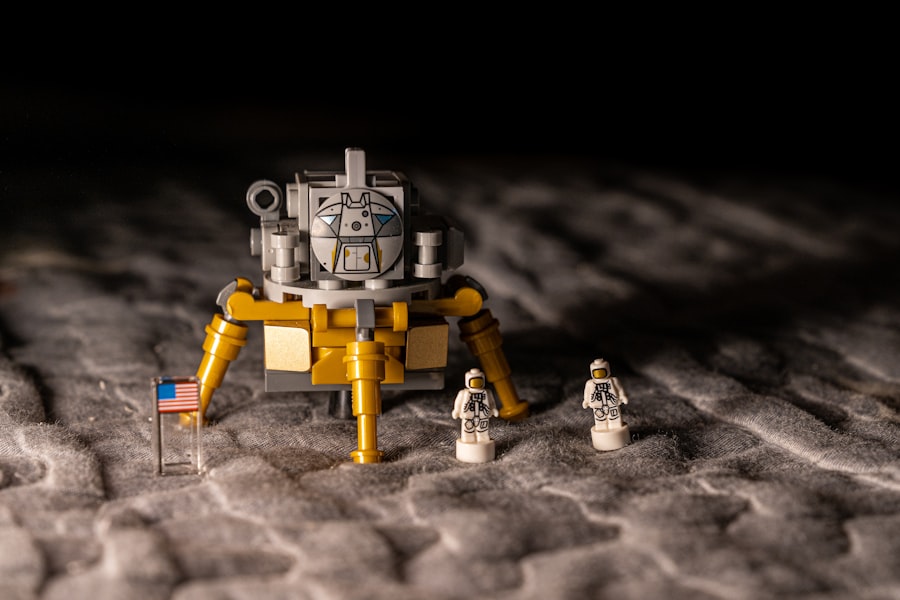The Moon’s South Pole has emerged as a focal point in contemporary discussions surrounding lunar exploration and potential exploitation. This region, characterized by its unique geological features and the presence of permanently shadowed craters, holds vast scientific and strategic significance. The South Pole is not only a site of interest for its potential resources, such as water ice, but also for its role in the broader context of space exploration.
As nations and private entities set their sights on this celestial body, the implications of their ambitions extend beyond mere exploration, raising questions about the future of lunar governance and the militarization of space. The allure of the Moon’s South Pole lies in its promise of untapped resources that could support long-term human presence on the Moon and beyond. Water ice, for instance, is crucial for sustaining life and could be converted into hydrogen and oxygen for fuel.
This makes the South Pole a prime candidate for establishing bases that could serve as launch points for deeper space missions. As humanity stands on the brink of a new era in space exploration, the Moon’s South Pole represents both a frontier of opportunity and a potential flashpoint for geopolitical tensions.
Key Takeaways
- The Moon’s South Pole is of great interest for potential exploration and resource exploitation due to its unique characteristics and potential for water ice.
- Historical lunar exploration has laid the groundwork for current interest in the Moon’s South Pole, with past missions providing valuable data and insights.
- The strategic importance of the Moon’s South Pole lies in its potential as a refueling station for deep space missions and its reservoir of water ice for life support and fuel.
- International competition for lunar resources is intensifying, with countries and private companies vying for access and control over valuable resources.
- Government space agencies and private companies are both playing significant roles in the militarization of the Moon’s South Pole, raising concerns about the weaponization of space.
Historical context of lunar exploration
Lunar exploration has a rich history that dates back to the mid-20th century, marked by the iconic Apollo missions that first landed humans on the Moon. The Apollo program, initiated by NASA in the 1960s, not only showcased human ingenuity but also ignited a global fascination with space. The successful landings on the lunar surface provided invaluable scientific data and samples, shaping our understanding of the Moon’s geology and history.
However, after the last Apollo mission in 1972, interest in lunar exploration waned for several decades, leading to a period of relative stagnation. In recent years, however, there has been a resurgence of interest in the Moon, driven by advancements in technology and a renewed focus on space exploration. Various nations have launched missions aimed at studying the Moon’s surface and potential resources.
The establishment of international partnerships and collaborations has further accelerated this momentum, as countries recognize the importance of working together to explore and utilize lunar resources. This historical context sets the stage for understanding the current race to the Moon’s South Pole and the motivations behind it.
The strategic importance of the Moon’s South Pole

The strategic importance of the Moon’s South Pole cannot be overstated. Its unique geographical features, including permanently shadowed regions that harbor water ice, make it an ideal location for future lunar bases. These bases could serve as hubs for scientific research, resource extraction, and even as launch points for missions to Mars and beyond.
The presence of water ice is particularly significant; it not only supports human life but can also be converted into rocket fuel, making deep space exploration more feasible. Moreover, control over the Moon’s South Pole could confer significant advantages in terms of technological development and national security. As nations vie for dominance in space, establishing a foothold on the Moon could provide strategic military advantages.
The ability to monitor Earth from lunar bases or to deploy advanced technologies could reshape global power dynamics. Thus, the South Pole is not merely a site for scientific inquiry; it is a potential battleground for influence in an increasingly competitive arena.
International competition for lunar resources
| Competition Category | Metrics |
|---|---|
| Participating Countries | 10 |
| Prize Money | 1,000,000 |
| Number of Teams | 15 |
| Competition Duration | 6 months |
As interest in lunar exploration intensifies, so too does competition among nations for access to lunar resources. The Moon’s South Pole is particularly coveted due to its potential reserves of water ice and other valuable materials. Countries such as the United States, China, and Russia have all expressed intentions to establish a presence on the Moon, leading to a race that echoes historical territorial disputes on Earth.
This competition raises questions about how resources will be allocated and who will have the right to exploit them. The international community is grappling with how to manage these competing interests while ensuring that lunar resources are used responsibly. The prospect of resource extraction on the Moon has sparked debates about ownership rights and equitable access.
As nations develop their strategies for lunar exploration, they must navigate complex legal and ethical considerations that will shape the future of lunar governance.
The role of government space agencies in the militarization of the Moon’s South Pole
Government space agencies play a pivotal role in shaping the trajectory of lunar exploration and potential militarization. Agencies like NASA, Roscosmos, and CNSA (China National Space Administration) are not only focused on scientific research but are also increasingly aware of the strategic implications of their missions. The establishment of lunar bases or outposts could serve dual purposes: advancing scientific knowledge while also enhancing national security capabilities.
The militarization of the Moon’s South Pole raises concerns about an arms race in space. As nations invest in technologies that could be used for military purposes—such as satellite systems or advanced robotics—the potential for conflict increases. Government agencies must balance their scientific objectives with national interests, leading to a complex interplay between exploration and militarization that could have far-reaching consequences.
Private sector involvement in lunar exploration and exploitation

In addition to government initiatives, private companies are becoming increasingly involved in lunar exploration and exploitation. Companies like SpaceX, Blue Origin, and others are developing technologies aimed at facilitating access to the Moon’s resources. This involvement marks a significant shift in how lunar exploration is conducted, as private entities bring innovation and investment to the table.
The participation of private companies introduces new dynamics into the competition for lunar resources. These entities often operate with different motivations than government agencies, focusing on profit and market opportunities rather than national prestige. As they seek to establish their foothold on the Moon, questions arise about regulation and oversight.
The collaboration between public and private sectors could lead to groundbreaking advancements but also poses challenges regarding accountability and ethical considerations.
Potential military applications of the Moon’s South Pole
The potential military applications of establishing a presence on the Moon’s South Pole are vast and varied. Control over this region could enable nations to deploy surveillance systems capable of monitoring activities on Earth or in space.
The strategic positioning offered by lunar bases could also facilitate rapid response capabilities in times of conflict or crisis. As nations invest in technologies that enhance their military capabilities, the Moon becomes an increasingly attractive platform for projecting power beyond Earth’s atmosphere. This militarization raises concerns about an escalation of tensions among nations as they vie for dominance over this new frontier.
Environmental and ethical concerns surrounding the militarization of the Moon’s South Pole
As discussions about militarization intensify, so too do concerns regarding environmental sustainability and ethical considerations. The Moon is a fragile environment that has remained largely untouched since its formation. The introduction of military activities could disrupt this delicate balance, leading to irreversible damage to its surface and ecosystems.
Ethically, there are questions about humanity’s right to exploit celestial bodies for military purposes. The principles governing space exploration emphasize cooperation and peaceful use; however, as nations pursue their interests on the Moon, these principles may be compromised. The potential for conflict over resources raises moral dilemmas about stewardship versus exploitation, challenging humanity’s collective responsibility toward outer space.
The legal framework for lunar activities
The legal framework governing lunar activities is complex and evolving. The Outer Space Treaty of 1967 established foundational principles regarding the use of outer space, emphasizing that celestial bodies should be used for peaceful purposes and prohibiting claims of sovereignty over them. However, as nations prepare to exploit lunar resources, questions arise about how existing treaties apply to contemporary challenges.
Recent discussions have focused on developing new agreements that address resource extraction and ownership rights on the Moon. The Artemis Accords, initiated by NASA in 2020, aim to establish guidelines for international cooperation in lunar exploration but have faced criticism regarding inclusivity and enforcement mechanisms. As more nations engage in lunar activities, establishing a robust legal framework will be essential to prevent conflicts and ensure equitable access to resources.
Potential implications for international relations and space governance
The race to establish a presence on the Moon’s South Pole has significant implications for international relations and space governance.
The potential for conflict over resources could strain diplomatic relations or lead to new forms of cooperation as countries recognize the need for collaborative approaches.
Moreover, how nations choose to govern their activities on the Moon will set precedents for future endeavors in space exploration. The establishment of norms regarding resource utilization, environmental protection, and military presence will shape international relations well beyond our planet. As humanity ventures further into space, fostering dialogue among nations will be crucial to ensuring that exploration remains peaceful and beneficial for all.
The future of the militarization of the Moon’s South Pole
Looking ahead, the future of militarization at the Moon’s South Pole remains uncertain but fraught with potential challenges and opportunities. As technological advancements continue to evolve rapidly, nations will likely seek to assert their presence on the Moon through both scientific endeavors and military capabilities. This dual approach may lead to increased tensions but also offers avenues for collaboration if managed effectively.
Ultimately, how humanity navigates this new frontier will depend on collective choices made today regarding governance, ethics, and cooperation in space exploration. The Moon’s South Pole stands as both a symbol of human ambition and a reminder of our responsibility toward preserving celestial environments while pursuing knowledge and progress beyond Earth’s boundaries. As nations grapple with these complexities, they must strive to ensure that their actions reflect a commitment to peaceful exploration rather than conflict-driven competition.
The militarization of the moon’s south pole has become a topic of increasing concern as nations vie for strategic advantages in space. This issue is not only about the potential for conflict but also the implications for international treaties and the future of space exploration. A related article on this topic can be found on Real Lore and Order, which delves into the geopolitical ramifications and the technological advancements driving this new space race. For more insights, you can read the full article here.
WATCH THIS! 🚀 Why The Moon Is The Next Battlefield: The Geopolitics of Cislunar Space
FAQs
What is the militarization of the moon’s south pole?
The militarization of the moon’s south pole refers to the potential development and deployment of military assets and infrastructure on the lunar surface, particularly in the southern polar region of the moon.
Why is there interest in militarizing the moon’s south pole?
There is growing interest in militarizing the moon’s south pole due to its strategic location and potential for valuable resources such as water ice. Nations are exploring the possibility of establishing a military presence to protect their interests and assert their influence in space.
What are the potential implications of militarizing the moon’s south pole?
Militarizing the moon’s south pole could lead to increased competition and tensions among spacefaring nations. It may also raise concerns about the weaponization of space and the potential for conflict beyond Earth’s atmosphere.
Are there any international regulations or treaties governing the militarization of celestial bodies like the moon?
The Outer Space Treaty, which was signed by the United Nations in 1967, prohibits the placement of nuclear weapons or any other weapons of mass destruction in outer space, including on the moon. However, there is ongoing debate about the interpretation and enforcement of this treaty in the context of lunar militarization.
What are some of the challenges associated with militarizing the moon’s south pole?
Challenges associated with militarizing the moon’s south pole include the high cost of establishing and maintaining a military presence in space, the technical difficulties of operating in a harsh lunar environment, and the ethical and legal implications of weaponizing celestial bodies.
